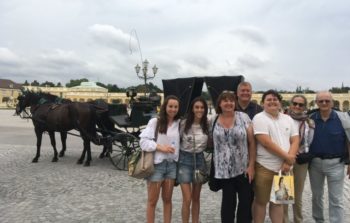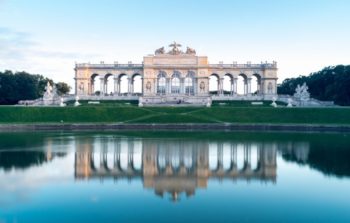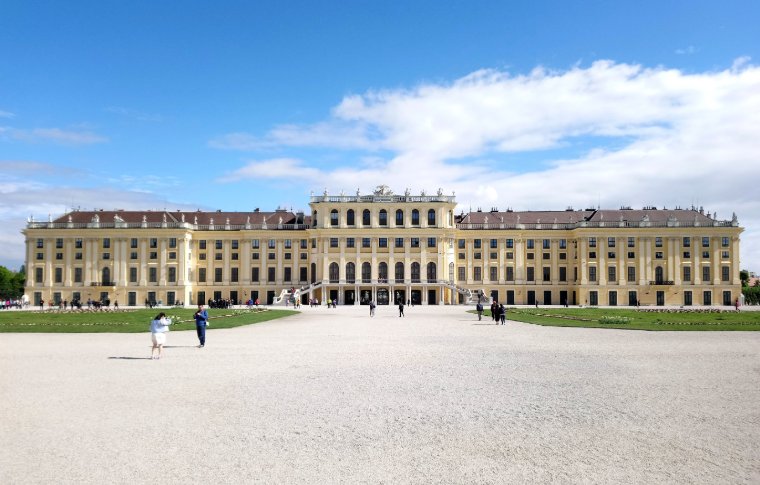We booked a historian guide for our first visit to Schonbrunn palace with Insight Cities. Meeting spot was excellent. We were lucky to have Ilse as our guide who has lived in Vienna all her life. She took care of our tickets, got our backpack and umbrella checked in and we were off to the gardens. She kept us on schedule without feeling rushed at anytime. Her passion and knowledge of Vienna made the Habsburg Dynasty come to life in this informative three hour tour. Ilse made the tour of the Palace 100% enjoyable!
Schönbrunn Palace and Gardens: Public Grandeur and Private Turmoil
2.5 Hours
Palace & Grounds Tour
Discover the Habsburgs through their Opulent Summer Residence
With your historian guide to lead the way, explore Schönbrunn Palace on this guided walking tour, and learn of the influential role culture and the Arts played in the imperial family’s life. Stroll through the grand dining room to the Hall of Ceremonies, the Porcelain Room, and the Millions Room, and admire ostentatious displays of the Habsburg rulers’ immense power, influence, and wealth. We’ll also take a turn through the lavish formal gardens and park, opened under Maria Theresa’s direction as the Habsburg dynasty’s political and cultural dominance reached its peak.
Meander through the manicured Gardens, passing the Grand Parterre with its fabulous view of the Gloriette in the distance, then on to the Neptune Fountain, finally strolling by the Roman ruin, Privy garden and Orangery. Throughout, your expert guide helps you explore the symbolism of statues as well as the Baroque landscaping philosophy interweaving nature and architecture.
Visit the extravagant music room, where the imperial family showcased their impressive musical accomplishments, and where a six-year-old Mozart famously performed.
Admire details of Baroque and Rococo design in the grand dining room, the Hall of Ceremonies, the Porcelain Room, and the Millions Room, and gain deep insight into the politics and privilege of court life.
Delve the personalities and often ill-fated lives of the imperial family, including Empress Maria Theresa, Emperor Franz Joseph, and Sisi - his country-reared consort, who struggled with the burdens of state.
Tour Details
Price
Private tour – $390 USD (1-10 persons)
*your guide all to yourself
Small groups – $125 USD per person
*still intimate with 8 persons or less
Departure time
Private tours: daily at 9:30 AM and 2 PM
Small groups:
- Monday 9:30 AM
- Wednesday 9:30 AM
- Thursday 2 PM
- Saturday 9:30 AM
Meeting point
Private tours include a pick-up at your central hotel or flat
Small groups: Meet your guide at the Schönbrunn Arrival Centre at Schönbrunner Schloßstrasse 50. Your guide waits in front of the Group Centre Building right across the street from the palace’s main entrance.
Availability
Year-round
Duration
Private tours: 3 hours
Small groups: 2.5 hours
Group size
Private tours: 1-10 persons
Groups of over 10 should contact us at info@insightcities.com in order to get a special rate for their party.
Small groups: 2-8 persons
Participation requirements
As this is a walking tour, please contact us if you have any mobility issues or concerns
Not included
Schönbrunn Palace & Park Tickets
- Individual: €29,00
- Students (aged 19-25): €24,00
- Kids (aged 6-18): €21,00
Note: please remember to wait until the beginning of your walk to purchase your tickets in the company of your guide. There will be no long lines to get your special admission ticket for a guided visit because you have a reserved tour.
What to bring
- Comfortable walking shoes
- Cash or credit card for the entrance fee
About your guide
Read about our Vienna guides
Cancellation policy
For cancellations 48 hours prior to your scheduled tour, Insight Cities offers a full refund. We cannot refund cancellations within 48 hours of a scheduled tour as we need to pay our guide.
Overview of Your Tour

Schönbrunn Palace Gardens and The Gloriette
We begin our tour of this astonishing palace with a stroll through the magnificent formal gardens, exploring the Baroque landscaping principle of interlaced nature and architecture illustrated throughout the grounds. Schönbrunn Palace was built to rival Versailles, though many say it surpasses the famous French palace in grandeur.
From the Grande Parterre, we gaze at the Gloriette in the distance, a huge triumphal arch situated on a hilltop with panoramic views of Vienna’s woods, which recalls the military victories that made Empress Maria Theresa’s reign (1740-1780) a highpoint of the Habsburg dynasty’s political and cultural dominance in Europe.
Strolling by the the Neptune Fountain, the Roman ruin, Privy garden and Orangery, we consider how this wondrous park was opened to the general public in 1779, a populist gesture that reveals Maria Theresa’s canny charm offensive towards her subjects. Indeed, it was under Maria Theresa’s direction that Schönbrunn Palace became the focal point of Austria’s imperial policy and the center of court life.

Schönbrunn Palace and Maria Theresa’s Music Room
Schönbrunn Palace functioned as the summer residence of a reigning family counting no fewer than 16 children! Many of this teeming brood of young royals did not survive to adulthood, but the palace sympathetically preserves the memories of their infancy, childhood summer activities, hobbies, illnesses, and early loss. Throughout our tour, your expert historian guide shares insight into daily life for the generations who called the palace home.
For example, the imperial family would regularly gather in Maria Theresa’s music room for performances and rehearsals, and a six-year-old Mozart even played for them here. The Habsburgs’ devotion to the development of classical music did not end at their support of brilliant composers; many of the children were trained as advanced musicians themselves and were expected to exhibit their skills in private entertainments held in this space. During our time here, we take a moment to admire the music room’s glittering Rococo mirrors and lavish chandeliers – regarded as late-Baroque.

The Franz-Joseph and Elisabeth Apartments
The next generation of Habsburg rulers also put their stamp on Schönbrunn, a point your knowledgeable guide will illustrate in the Franz-Joseph and Elisabeth Apartments.
In 1854, Emperor Franz Joseph married the Bavarian princess Elisabeth (known by the affectionate nickname Sisi), who despised the rituals of court life and the ornate surroundings of the summer palace. She even went as far as to commission a spiral staircase leading from her official rooms to a private passage, from which she could flee the palace to the gardens beyond. As we explore the opulent apartments, your guide shares valuable insight into the story of a couple torn apart by the burdens of the State.
The Hall of Ceremonies, Porcelain Room, and Millions Room
Visiting one lavish space after another, we gain a sense of the relentless opulence which Sisi found so unbearably stifling – such as the spectacular dining room, with its precious tableware and “imperial napkins” in the form of the fleur-de-lys.
We’ll stroll through the Hall of Ceremonies – where lavish celebrations such as the wedding of Crown Prince Joseph were held – and the so-called Porcelain Room (Maria Theresa’s private office), with its décor actually designed by the imperial children themselves in an elegant chinoiserie style.
In the unique Millions Room – which earned its name through its eye-watering price tag – we admire antiquated Indo-Persian miniatures with rococo-frames, and wall hangings manufactured in carved rosewood from the Antilles. Such impressive features work together to make the Millions Room one of the most accomplished combinations of Rococo-era Oriental and European decorative art in the world.

Good to Know
Please remember to wait until the beginning of your walk to purchase your tickets for the palace in the company of your guide.
See Our FAQs for More Information
See What Our Guests are Saying
The tour was perfect in length and showed us everything we wanted to see. Ilse, our tour guide, was extremely knowledgeable and had a fun and hospitable personality. I would highly recommend this tour.
Our guide was so informative and interesting. She spent so much time with us. We walked for hours around the grounds and palace. Best tour ever.
















